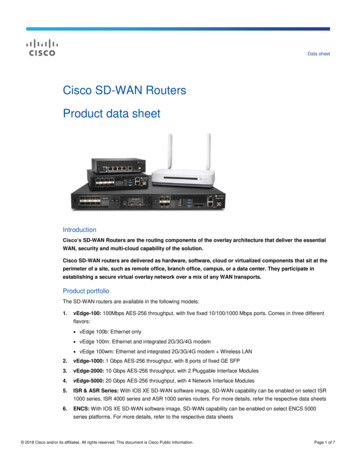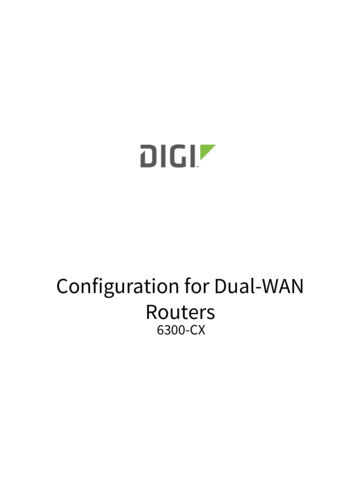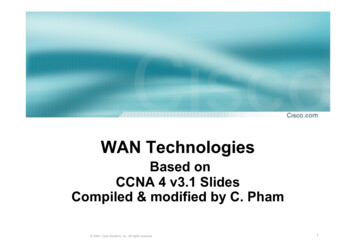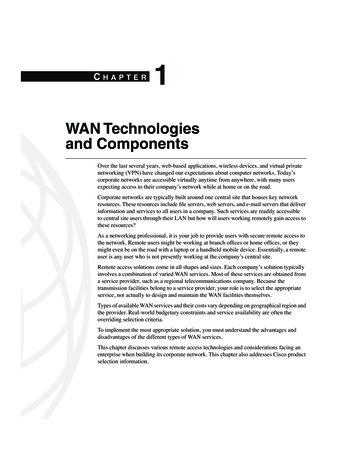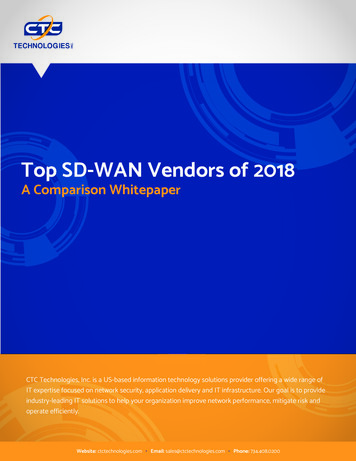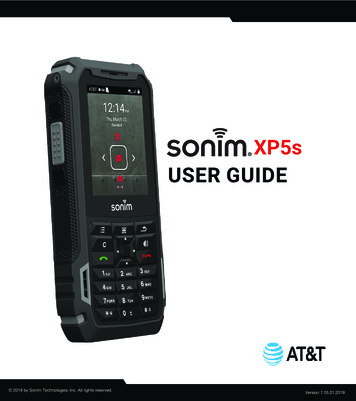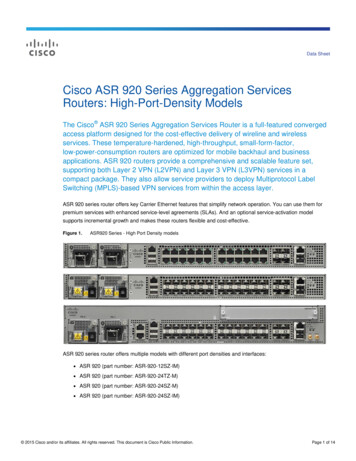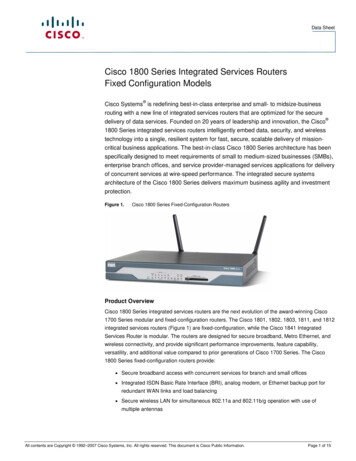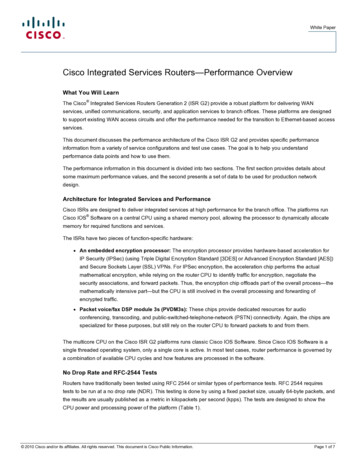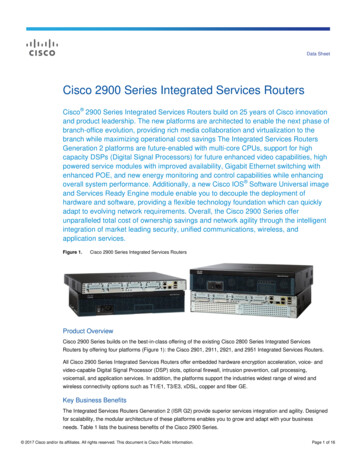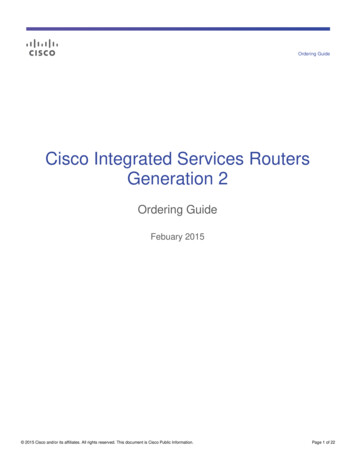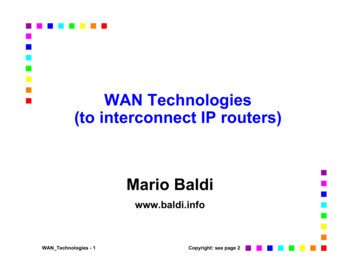
Transcription
WAN Technologies(to interconnect IP routers)Mario Baldiwww.baldi.infoWAN Technologies - 1Copyright: see page 2
Copyright NoticeThis set of transparencies, hereinafter referred to as slides, is protected bycopyright laws and provisions of International Treaties. The title andcopyright regarding the slides (including, but not limited to, each and everyimage, photography, animation, video, audio, music and text) are property ofthe authors specified on page 1.The slides may be reproduced and used freely by research institutes,schools and Universities for non-profit, institutional purposes. In suchcases, no authorization is requested.Any total or partial use or reproduction (including, but not limited to,reproduction on magnetic media, computer networks, and printedreproduction) is forbidden, unless explicitly authorized by the authors bymeans of written license.Information included in these slides is deemed as accurate at the date ofpublication. Such information is supplied for merely educational purposesand may not be used in designing systems, products, networks, etc. In anycase, these slides are subject to changes without any previous notice. Theauthors do not assume any responsibility for the contents of these slides(including, but not limited to, accuracy, completeness, enforceability,updated-ness of information hereinafter provided).In any case, accordance with information hereinafter included must not bedeclared.In any case, this copyright notice must never be removed and must bereported even in partial uses.WAN Technologies - 2Copyright: see page 2
The ContextIP hostIP networkWide AreaIP routerWAN Technologies - 3Copyright: see page 2
Why Not Just Cables?Expensive! Time consuming WAN Technologies - 4To lay To modify Copyright: see page 2
Use a NetworkCables are laid once Interconnectivity can be configured Resources (and their costs) shared Interconnecting anew site implies justlaying a “short” cableWAN Technologies - 5New “virtual” interconnectionscan be easily and quicklyCopyright: see page 2created
And before building new onesReuse existing technologies Specifically, existing networksThey are “Dead”: there is no new development Old: designed tens of years ago withvarious purposes in mind Not for interconnecting IP routersWith one exception (frame relay) but huge investmentsWAN Technologies - 6Copyright: see page 2
Commonly Deployed Technologies Circuit switching ISDN PDH SONET/SDHFrame Relay ATM Dead and old, but still heavily used relevant![also optical networks, which are a (relatively)new technology]WAN Technologies - 7Copyright: see page 2
Circuit Switching TechnologiesWAN Technologies - 8Copyright: see page 2
TDM: Time Division MultiplexingSwitchSwitchBANDWIDTHWAN Technologies - 9Copyright: see page 2
Interconnections based on TDM TDM (Time Division Multiplexer) dividethe total bandwidth in sub-bandsEach network user (e.g., router) can “see”only its assigned sub-band as asynchronous channel with fixed bit rate Routers can use a channel as the equivalentof a physical link In reality at any given time the link carriestraffic of only one user WAN Technologies - 10Copyright: see page 2
TDM: Time Division MultiplexingTake turnsSwitchSwitchBANDWIDTHat predefined, recurring time instants time rulesWAN Technologies - 11Copyright: see page 2
Good service without flexibility(by design) Deterministic performance Delay Jitter BandwidthFixed rate Bandwidth not actually used by a user (in acertain interval of time) cannot be used byother services and it is wasted Highercosts Particularly for bursty traffic E.g., data trafficDesigned for voice trafficWAN Technologies - 12Copyright: see page 2
Standard Channel HierarchiesStandardized channel speeds Standardized transmission speeds And corresponding equipmentTransmittersReceiversCables CopperFibersHow to combine multiple lowchannels into a high speedtransmitted on a link MultiplexingWAN Technologies - 13and demultiplexingCopyright: see page 2speedsignal
PDH: Plesiochronous Digital Hierarchy Looser synchronization requirementsEuropeUSAE12.048 MbpsT1 - DS11.544 Mbps32 x 64 kb/s16E334.368 Mbps28T3 - DS344.736 Mbps4E4139.26 MbpsLimited transmission speeds High overhead WAN Technologies - 14Copyright: see page 224 x 64 kb/s
Why a hierarchy?Hierarchy: how to combine multiple lowerrate frames into higher rate frame Higher capacity links in the backbone, lowercapacity at the access GroomingWAN Technologies - 15and degroomingCopyright: see page 2
USA: SONETEurope: SDHOC-1c / STS-1c51.84 MbpsOC-3c / STS-3c155.52 MbpsSTM-1155.52 MbpsOC-12c / STS-12c622.08 MbpsSTM-4622.08 MbpsOC-48c / STS-48c2.4 GbpsSTM-122.4 GbpsHigher transmission speeds Lower overheadWAN Technologies - 16Copyright: see page 2 Higher complexity costsMore stringent synchronizationSDH: Synchronous Digital HierarchySONET: Syncronous Optical Network
USAUSA: SONETE12.048 MbpsT1 - DS11.544 MbpsOC-1c / STS-1c51.84 MbpsE334.368 MbpsT3 - DS344.736 MbpsE4139.26 MbpsWAN Technologies - 17Europe: SDHOC-3c / STS-3c155.52 MbpsSTM-1155.52 MbpsOC-12c / STS-12c622.08 MbpsSTM-4622.08 MbpsOC-48c / STS-48c2.4 GbpsSTM-122.4 GbpsCopyright: see page 2
Physical architectureSection: fiber optic between repeaters Line: sequence of sections between devices oeprating at line ctionLinePathWAN Technologies - 18SONET/SDHMUXTAdd/DropMUXPath: end-to-end connectionSONET/SDHMUX Copyright: see page 2TTT
Protocol architecture Multiple layers Complex protocol architectureMonitoring functionalites Fast fault recovery 50ms Ring topologyTerminalRepeaterMultiplexerHigher LayerHigher LayerEnvelopePath LayerLine LayerSection LayerSTS-N / STM-N BlockFramePhotonic LayerPath LayerLine LayerLine LayerSection LayerSection LayerSection LayerPhotonic LayerPhotonic LayerPhotonic LayerLightWAN Technologies - 19TerminalCopyright: see page 2
Frame formatSTS-1: 810 bytes transmitted in 125 s 51.84 Mbps90 octets9 octets s3 octetsSynchronous Payload Environment (SPE) 87 H4D7D8D9Z3D10D11D12Z4Z1Z2E2Z5Section OverheadWAN Technologies - 20PayloadF2Line OverheadPayloadPath OverheadCopyright: see page 2 s
Frames In packet switching Framecontains bytes of a single communication Destination (source) identified in the header Frames are transmitted asynchronously Whenever there is data to transmit Whenever a link is free Statistical multiplexing In circuit switching Framecontains bytes of multiple communications Destination (source) identified by the position Frames are transmitted synchronously Back-to-back Independently of whether there is data to transmitWAN Technologies - 21Copyright: see page 2
What do we do with them? Same duration (125 µs) at any bit rate 1byte carries one 64kb/s channelMore bytes per frame at higher rates Hierarchy: how to combine multiple lowerrate frames into higher rate frame Higher capacity links in the backbone, lowercapacity at the access GroomingWAN Technologies - 22and degroomingCopyright: see page 2
How do we connect routers? One channel between two routers All bytes in a frameA fraction of a channel MultipleWAN Technologies - 23bytes in a frameCopyright: see page 2
But this is not the way it wasmeant to be used Voice Integrated servicesWAN Technologies - 24Copyright: see page 2
ISDN Integrated Service Digital INALCOMPUTERFACSIMILEGROUP 4So what?VIDEOTELEPHONENow it is normal, but back then it was a big step forwardWAN Technologies - 25Copyright: see page 2
ISDN Access InterfaceVideoconferenceISDN phoneBus SNT1ISDNExchange(Multiplexer)PC with ISDN Fax G.4Customer PremisesWAN Technologies - 26Copyright: see page 2Operator
ISDN Access InterfaceData voice The user terminal becomes digital 2B D or base access 2 data channels at 64 kbps1 signaling channel at 16 kbpstotal 144 kbps up to user's premises30B D or primary access 30 data channels at 64 kbps1 signaling channel at 64 kbpstotal 2 Mbps up to user's premisesWAN Technologies - 27Copyright: see page 2
Packet Switching TechnologiesWAN Technologies - 28Copyright: see page 2
Packet-based multiplexing/switching Ifa source has no traffic, bandwidth isnot wasted Statisticalmultiplexing Thesame network infrastructure canstatisticallyaccommodatemorecommunications Costof communicating is lower Service is not deterministicWAN Technologies - 29Copyright: see page 2
Statistical MultiplexingSwitchSwitchBANDWIDTHWAN Technologies - 30Copyright: see page 2
Statistical MultiplexingTake turnsSwitchSwitchBANDWIDTHopportunistically, i.e., as soon as link isavailableWAN Technologies - 31Copyright: see page 2
Statistical MultiplexingIf one is using less, others can use moreSwitchSwitchBANDWIDTHWAN Technologies - 32Copyright: see page 2
Building packet switching on topof circuit switchingUse circuits through a circuit network tointerconnect packet/frameswitches/routersX.25Frame RelayPacket switchingATMCell switchingPDHWAN Technologies - 33SDHCopyright: see page 2
Frame RelayWAN Technologies - 34Copyright: see page 2
Frame Relay Network ArchitectureData Communication EquipmentDTEDTEDCEDCEFrame RelayNetworkDCEDTEDCEVirtualCircuitsData Terminal EquipmentWAN Technologies - 35Copyright: see page 2DTE
Frame Relay standard Standard for DCE-DTE interfaces Multiplelogical connections through a singleaccess link Similarly to X.25 Layer 2 only Switchesdo not need to process 2 headers (layer2 and layer 3) like in the previous X.25 X.25 does have a layer 3WAN Technologies - 36Copyright: see page 2
Core-Edge Approach Error correction: re-transmission only at thenetwork edge, not in the intermediate nodes(core) X.25corrects errors at each hopRequires reliable links Takes advantage of fast links Small latency: 2ms per frame relay node from 5 to 20 ms per X.25 nodeWAN Technologies - 37Copyright: see page 2
Frame Relay applications Interconnection of Intermediate Systems(router, bridge, gateway) through WANs Allcommercial devices offer FR interfaces Physical layer is common (PDH) Data-link layer is implemented in softwareIt is possible to specify the bandwidthrequired by/provided to the customer Variable transit times Problematic with voice/video transmissionWAN Technologies - 38Copyright: see page 2
CIR: Committed Information Rate Bc: committed burst size Maximum burstinessTc Bc/CIR Intervalof time where CIR is applied It is possible to transmit up to Bc bit at wire speedof the access link in each time interval TcNon guaranteedserviceWire speedBcCIRGuaranteedserviceTcWAN Technologies - 39Copyright: see page 2
Asynchronous Transfer Mode (ATM)WAN Technologies - 40Copyright: see page 2
Relationships among differenttechnologiesanalog telephonyleased analogDigital conversiondigital telephonyvoice SMDSFrame RelaycellsWAN Technologies - 41 core-edgecellsB-ISDNpacketleased digital frameATMCopyright: see page 2
Distinguishing FactorsProtocol ArchitectureSystem design choicesCore & EdgeCellsAsynchronous interconnectionservcesATMEnabling technlogiesOptical fibersVLSI (CMOS)WAN Technologies - 42Copyright: see page 2
General features Switching of small, fixed length data units:cells 53 Fast links (with low bit error rate) bytes150 Mb/sLow latency Goodfor data, voice and videoFor deployment in both LAN and WAN Selected for implementing the B-ISDN WAN Technologies - 43Copyright: see page 2
General features Sophisticated signaling: Multiparty Sophisticated mechanisms for flow control Sliding or point-to-point connectionswindow is not efficient on long, fat pipesDynamic bandwidth allocation BandwidthmanagementFine granularity in bandwidth allocation Support for “bursty” traffic Adaptabilityfor applications that aresensible to time or data loss Anything else?!?!WAN Technologies - 44Copyright: see page 2
Virtual channelsATM net4 Mbps (3 party conference)50 Mbps (Image transfer)ATM SwitchWAN Technologies - 45Copyright: see page 2
Cell switchingATMSwitch548Cell 53 bytesWAN Technologies - 46Copyright: see page 2
Statistical multiplexingAABCWAN Technologies - 47MultiplexATMCACCopyright: see page 2BCA
ATM technologySwitchSwitchBANDWIDTHATMSwitchWAN Technologies - 48ATMSwitchCopyright: see page 2
ATM ayload6User Data.(48 octets).53UNI CellWAN Technologies - 49Copyright: see page 2
Header Field NamesGFC: General Flow Control VPI: Virtual Path Identifier VCI: Virtual Channel Identifier PT: Payload Type CLP: Congestion Loss Priority HEC: Header Error Control WAN Technologies - 50Copyright: see page 2
A couple more detailsCellsaretransmittedback-to-back,poossibly inserting empty ones Each cell carries an indentifier of the circuit VCI/VPI: Virtual Channel/Path IdentifierError correction: Core-edge approach as in frame relayFlow control more sophisticatedsliding windows, to take into account: Differenttypes of traffic The“memory” of the channelWAN Technologies - 51Copyright: see page 2than
Look-upport #2Port LabelCell RoutingBAiD1C1122CDinmVCI/VPI changes each time an ATM switch is traversedWAN Technologies - 52Copyright: see page 2
Core-Edge Principle Nodes execute only basic functionalities(switching and multiplexing) ATM Layer (L1-L2 OSI stack)Additional functionalities for the differentservices are implemented at the edgeUpperlayerprotocolsAALUpperlayerError control (only for some services and upon request) protocolsAALATMATM (core)ATMPHYPHYPHYUserterminalWAN Technologies - 53PHYATMswitchCopyright: see page 2Userterminal
B-ISDN/ATM Reference ModelATM Adaption Layer (AAL)ATM LayerPhysical L
WAN_Technologies -2 Copyright: seepage 2 Copyright Notice des,isprotectedby copyright laws and provisions of .
